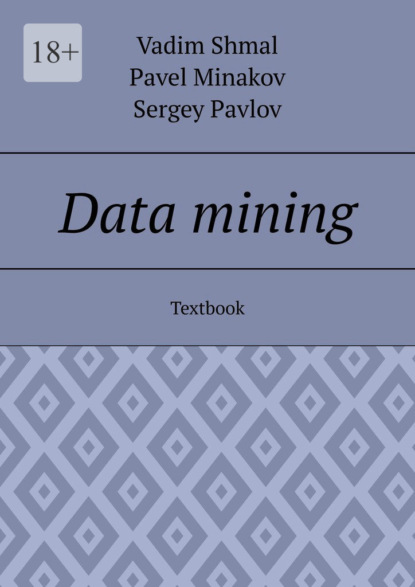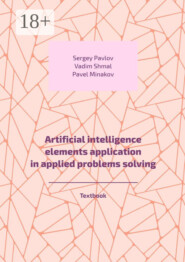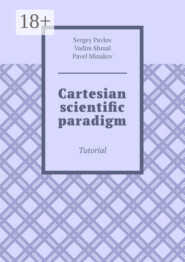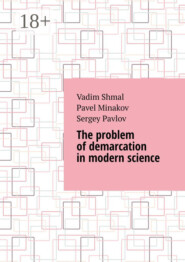По всем вопросам обращайтесь на: info@litportal.ru
(©) 2003-2024.
✖
Data mining. Textbook
Настройки чтения
Размер шрифта
Высота строк
Поля
Analyzing data anomalies is critical to learning about processes and improving their performance. It provides information about the nature of the process. This information can be used in evaluating the impact of the deviation, evaluating the risks and benefits of applying process adjustments. After all, data anomalies are important because they give insight into processes.
The ongoing process of evaluating the impact of data anomalies provides valuable insights. This information provides useful information about the process and provides decision makers with information that can be used to improve the effectiveness of the process.
This approach makes it possible to create anomalies in the data, which makes it possible to evaluate the impact of the anomaly. The goal is to gain insight into processes and improve their performance. In such a scenario, the approach gives a clear idea of the type of process change that can be made and the impact of the deviation. This can be useful information that can be used to identify process anomalies that can be assessed to assess the effect of deviation. The process of identifying process anomalies is very important to provide valuable data for assessing potential anomalies in process performance.
Anomaly analysis is a process that estimates the frequency of outliers in the data and compares it to the background frequency. The criterion for evaluating the frequency of data deviation is the greater number of data deviations, and not the natural occurrence of data anomalies. In this case, the frequency is measured by comparing the number of data deviations with the background of the occurrence of data deviations.
This provides information on how much data deviation is caused by the process over time and the frequency of deviation. It can also provide a link to the main rejection process. This information can be used to understand the root cause of the deviation. A higher data rejection rate provides valuable insight into the rejection process. In such a situation, the risk of deviation is likely to be detected and necessary process changes can be assessed.
Many studies are conducted on the analysis of data anomalies to identify factors that contribute to the occurrence of data anomalies. Some of these factors relate to processes that require frequent process changes. Some of these factors can be used to identify processes that may be abnormal. Many parameters can be found in systems providing process performance.
Association Rule Learning
Association rule learning is a rule-based machine learning technique for discovering interesting relationships between variables in large sample databases. This technique is inspired by the auditory system, where we learn the association rules of an auditory stimulus and that stimulus alone.
Sometimes when working with a dataset, we are not sure if the rows in the dataset are relevant to the training task, and if so, which ones. We may want to skip those rows in the dataset that don’t matter. Therefore, associations are usually determined by non-intuitive criteria, such as the order in which these variables appear in a sequence of examples, or duplicate values in these data rows.
This problematic aspect of learning association rules can be eliminated in the form of an anomaly detection algorithm. These algorithms attempt to detect non-standard patterns in large datasets that may represent unusual relationships between data features. These anomalies are often detected by pattern recognition algorithms, which are also part of statistical inference algorithms. For example, the study of naive Bayes rules can detect anomalies in the study of association rules based on a visual inspection of the presented examples.
In a large dataset, a feature space can represent an area of an image as a set of numbers, in which each image pixel has a certain number of pixels. The characteristics of an image can be represented as a vector, and we can place this vector in the feature space. If the attribute space is not empty, the attribute will be the number of pixels in the image that belong to a particular color.
Clustering
Clustering is the task of discovering groups and structures in data that are «similar» to some extent, not by using known structures in the data, but by learning from what is already there.
In particular, clustering is used in such a way that new data points are only added to existing clusters, without changing their shape to fit the new data. In other words, clusters are formed before data is collected, rather than fixed after all data is collected.
Given a set of parameters for data that is (mostly) variable, and their «collinearity», clustering can be thought of as a hierarchical algorithm for finding clusters of data points that satisfy a set of criteria. Parameters can be grouped into one of two categories: parameter values that define the spatial arrangement of clusters, and parameter values that define relationships between clusters.
Given a set of parameters for a dataset, clustering can be thought of as discovering those clusters. What parameters do we use for this? The implicit clustering method, which finds the nearest clusters (or, in some versions, clusters more similar to each other) with the least computational cost, is probably the simplest and most commonly used method for doing this. In clustering, we aim to keep the clusters as closely related to each other as possible – whether we do this by taking more measurements or by using only a certain technique to collect data.
But what is the difference between clustering and splitting data into one or more datasets?
The methods of implicit clustering and managed clustering are actually very similar. The only difference is that we use different parameters to determine in which direction we should split the data. Take as an example a set of points on a sphere that define an interconnected network. Both methods aim to keep the network as close as possible to the network defined by the two nearest points. This is because we don’t care if we are very far from one or the other. So, using the implicit clustering algorithm (cluster distance), we will divide the sphere into two parts that define very different networks: one will be the network defined by the two closest points, and the other will be the network defined by the two farthest points. The result is two completely separate networks. But this is not a good approach, because the further we move away from the two closest points, the smaller the distance between the points, the more difficult it will be to find connections between them – since there is a limited number of points that are connected by a small distance.
On the other hand, the method of controlled clustering (cluster distance) would require us to measure the length between each pair of points, and then perform calculations that make the networks closest to each other the smallest distance possible. The result is likely to be two separate networks that are close to each other but not exactly the same. Since we need two networks to be similar to each other in order to detect a relationship, it is likely that this method will not work – instead, the two clusters will be completely different.
The difference between these two methods comes down to how we define a «cluster». The point is that in the first method (cluster distance) we define a cluster as a set of points belonging to a network similar to a network defined by two nearest points. By this definition, networks will always be connected (they will be the same distance apart) no matter how many points we include in the definition. But in the second method (clustering control), we define clusters as pairs of points that are the same distance from all other points in the network. This definition can make finding connected points very difficult because it requires us to find every point that is similar to other points in the network. However, this is an understandable compromise. By focusing on finding clusters with the same distance from each other, we are likely to get more useful data, because if we find connections between them, we can use this information to find the relationship between them. This means that we have more opportunities to find connections, which will make it easier to identify relationships. By defining clusters using distance measurements, we ensure that we can find a relationship between two points, even if there is no way to directly measure the distance between them. But this often results in very few connections in the data.
Looking at the example of creating two datasets – one for implicit clustering and one for managed clustering – we can easily see the difference between the two methods. In the first example, the results may be the same in one case and different in another. But if the method is good for finding interesting relationships (as it usually is), it will give us useful information about the overall structure of the data. However, if the technique is not good at identifying relationships, then it will give us very little information.
Let’s say we are developing a system for determining the direction of a new product and want to identify similar products. Since it is not possible to measure the direction of a product outside the system, we will have to find relationships between products based on information about their names. If there is a good rule that we can use to establish relationships between similar products, then this information is very useful as it allows us to find interesting relationships (by identifying similar products that appear close to each other). However, if the relationship between two products isn’t very obvious, it’s likely that it’s just an unrelated relationship – which means the feature detection method we choose may not matter much. On the other hand, if the relationship is not very obvious but extremely useful (as in the example above), then we can start to learn how the product name is related to the process the product went through. This is an example of how different methods can produce very different results.
Unlike the characteristics of different methods, you also have different possible techniques. For example, when I say that my system uses image recognition, it doesn’t necessarily mean that the process the product goes through uses image recognition. If there are product images that we have taken in the past, or if we have captured some input from a product image, the resulting system will probably not use image recognition. It could be something completely different – something much more complex. Each of these methods is capable of identifying very different things. The result may depend on the characteristics of the actual data or on the data used. This means it’s not enough to look at a specific type of tool – we also need to look at what type of tool will be used for a particular type of process. This is an example of how data analysis should not be focused only on the problem being solved. Most likely, the system goes through many different processes, so we need to look at how different tools will be used to create a relationship between two points, and then decide which type of data to consider.
Often, we will be more concerned with how the method will be applied. For example, we might want to see what type of data is most likely to be useful for finding a relationship. We see that there is not much difference in how natural language processing is applied. This means that if we want to find a relationship, natural language processing is a good choice. However, natural language processing does not solve every possible relationship. Natural language processing is often useful when we want to take a huge number of small steps, but natural language processing does nothing when we want to go really deep. A look at natural language processing allows you to establish relationships between data that cannot be done using other methods. This is one of the reasons why natural language processing can be useful but not necessary.
However, natural language processing often doesn’t find as strong connections as image recognition because natural language processing focuses on simpler data whereas image recognition looks at very complex data. In this case, natural language processing is not very good, but can still be useful. Considering natural language processing is not always the best way to solve a problem. Natural language processing can be useful if the data is simple, but sometimes it is not possible to work with very complex data.
This example can be applied to many different types of data, but natural language processing is generally more useful for natural language data such as text files. For more complex data (such as images), natural language processing is often not enough. If there is a problem with natural language processing, it is important to consider other methods such as detecting words and determining what data is actually stored in an image. This data type will require a different data structure to find the relationship.
With the increasing complexity of technology, we often don’t have time to look at the data we’re looking at. Even if we look at the data, we may not find a good solution, because we have a large number of options, but not much time to consider them all. This is why many companies have a data scientist who can make many different decisions and then decide what works best for the data.
Classification
Classification is the task of generalizing a known structure to be applied to new data. For example, an email program might try to classify an email as «legitimate», or «spam», or maybe «deleted by the administrator», and if it does this correctly, it can mark the email as relevant to the user.
However, for servers, the classification is more complex because storage and transmission are far away from users. When servers consume huge amounts of data, the problem is different. The job of the server is to create a store and pass that store around so that servers can access it. Thus, servers can often avoid disclosing particularly sensitive data if they can understand the meaning of the data as it arrives, unlike the vast pools of data often used for email. The problem of classification is different and needs to be approached differently, and current classification systems for servers do not provide an intuitive mechanism for users to have confidence that servers are classifying their data correctly.
This simple algorithm is useful for classifying data in databases containing millions or billions of records. The algorithm works well, provided that all relationships in the data are sufficiently different from each other and that the data is relatively small in both columns and rows. This makes data classification useful in systems with relatively little memory and little computation, and therefore the classification of large datasets remains a major unsolved problem.
The simplest classification algorithm for classifying data is the total correlation method, also known as the correlation method. In full correlation, you have two sets of data and you are comparing data from one set to data from another set. This is easy to do for individual pieces of data. The next step is to calculate the correlation between the two datasets. This correlation of two sets of data tells you what percentage of the data is in each set. Thus, using this correlation, you can classify data as either one set or the other, indicating the parts of the data set that come from one set or the other.
This simple method often works well for data stored in simple databases with a small amount of data and slow data access speeds. For example, a database system may use a tree structure to store data, with the columns of a record representing fields in the structure. This structure did not allow data to be ranked because the data would be in two separate rows of the tree structure. This makes it impossible to make sense of the data if the data fits in only one tree structure. If the database has two data trees, you will need to compare each of the two trees. If there were a large number of trees, the comparison could be computationally expensive.
Therefore, full correlation is a poor classification method. Data correlation does not distinguish between relevant parts of the data, and the data is relatively small in both columns and rows. These problems make full correlation unsuitable for simple data classification systems and data storage systems. However, if the data is relatively large, full correlation can be applied. This example is useful for storage systems with a relatively high computational load.
Combining a data classification method with a data storage system improves both performance and usability. In particular, the size of the resulting classification algorithm is largely independent of the size of the data store. The detailed classification algorithm does not require a lot of memory to store data at all. It is often small enough to be buffered, and many organizations store their classification systems this way. Also, the performance characteristics of the storage system do not depend on the classifier. The storage system can handle data with a high degree of variability.
Why are classification systems not so good?
Most storage systems do not have a good classifier, and the data classification system is unlikely to get better over time. If your storage system does not have a good classifier, your classification system will have problems.
Most companies don’t think this way about their storage systems. Instead, they assume that the system can be fixed. They see it as something that can be improved over time based on future maintenance efforts. This belief also makes it easy to fix some of the problems that come from bad storage systems. For example, a storage system that doesn’t accept overly short or jumbled data can be improved over time if more people are involved in fixing it.








